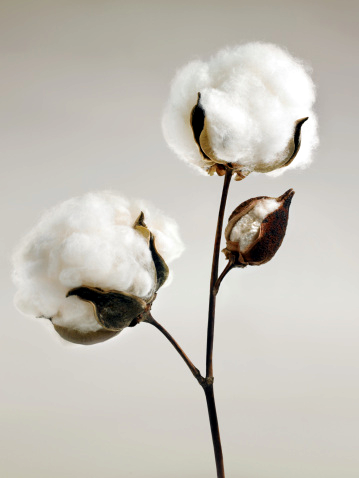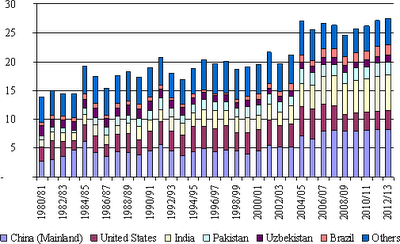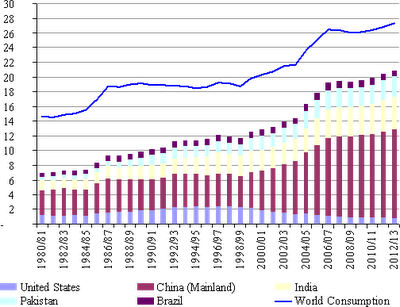Apr 13, 2025
Apr 13, 2025
 Cotton is considered the world's 'dirtiest' crop due to its heavy use of insecticides, the most hazardous pesticide to human and animal health. Cotton covers 2.5% of the world's cultivated land yet uses 16% of the world's insecticides, more than any other single major crop.
Cotton is considered the world's 'dirtiest' crop due to its heavy use of insecticides, the most hazardous pesticide to human and animal health. Cotton covers 2.5% of the world's cultivated land yet uses 16% of the world's insecticides, more than any other single major crop.
Cotton is one of the most water and pesticide intensive agricultural commodity, is responsible for significant adverse impacts on human and animal (livestock) health, natural resources such as land and fresh water and global biodiversity.
1. Cotton production plays a primary role in degradation of agro-ecosystems by indiscriminate use of agrochemicals such as fertilizers and pesticides. In addition, adverse impacts on the communities in terms of health risks to working men and women and increase in poverty and dependency due to the high pesticides costs and indebtedness are common.
2. In many cases irrigation systems are very inefficient and therefore lead to wide spread negative impacts on soil fertility and to water logging and salinity.
Cotton is a natural fiber that finds use in many products. These range from clothing to home furnishings to medical products. As a result, cotton is always in demand though its use is subject to the strengths and weaknesses of the overall economy. It accounts for 8.2 percent of the value added in agriculture and about 2 percent to GDP.Cotton has the ability to grow anywhere that has ample soil moisture and at least 200 frost free days per year. Droughts and competition with other crops for land can cause extreme volatility in cotton futures prices.
About two thirds of the harvested crop is composed of the seed, which is crushed to separate its three products –oil, meal and hulls. Cottonseed oil is a common component of many food items, used primarily as a cooking oil, shortening and salad dressing. The oil is used extensively in the preparation of such snack foods as crackers, cookies and chips. The meal and hulls are used as livestock, poultry and fish feed and as fertilizer.
World cotton production (million tonnes), by main countries, 1980/81 - 2012/13

Source: UNCTAD secretariat, based on International Cotton Advisory Committee (ICAC) statistics
Cotton has been used in India for at least 5,000 years and was also used by the ancient Chinese, Egyptians and North and South Americans. Cotton was one of the earliest crops grown by European settlers in the United States. Cotton is a naturally occurring vegetable fiber coming from small trees and shrubs of a genus belonging to the mallow family which includes the common Upland cotton plant. Cotton requires a long growing season, plenty of sun and water while growing and then dry weather for harvesting.
These 126-year-old contracts leverage for 50,000 lbs. of cotton. Cotton future contracts' antiquity are only rivaled by corn contracts that began trading about the same time in Chicago that cotton was trading in New York. Although cotton's economic role has diminished over the last century, it is still an extremely important commodity in today's economic picture.
Pakistan’s textile sector, which accounts for 60 per cent of the country’s exports, is likely to be hit due to damage to the cotton crop, which could be 20 per cent below usual, according to analysts."Large fields of cotton have been washed away by the floods," said Ibrahim Mughal, analyst with Pakistan’s independent Agri Forum organisation. "We will be short of about three million bales, which will burden our already fragile economy by at least one billion dollars," Mughal said.
Cotton consumption (million tonnes), by main countries, 1980/81-2012/13

Source: UNCTAD secretariat, based on International Cotton Advisory Committee (ICAC) statistics
Pakistan is one of the main importers of cotton from India, which is the second largest producer of the crop worldwide after China. In 2010 Pakistan had successfully become the pioneer country in the world to produce certified ‘Better Cotton’. This has been accomplished under the ‘Better Cotton Initiative’ (BCI) of World Wide Fund for Nature – Pakistan (WWF – Pakistan). The special cotton yield is termed ‘Better Cotton’ as it is produced keeping strict environmental and ethical standards in place. The news was confirmed by Lise Melvin, Executive Director of Better Cotton Initiative and Hammad Naqi Khan of WWF - Pakistan. Pakistan’s devastating floods had destroyed up to a fifth of the country’s cotton crop in 2010, analysts say, handing an opportunity to exporters in neighbouring India who are eyeing the shortfall. China, USA and India produce roughly 65% of the global supply of cotton. Uzbekistan is the world's second leading exporter of cotton.
Top Producers 2010-2011
China (produces about 26% of world supply)
India (produces about 22% of world supply)
United States (produces about 15% of world supply)
Pakistan
Top Consumers
China (consumes about 40% of world supply)
India (consumes about 18% of world supply)
Pakistan
Pakistan cotton varieties have a potential of producing more than 45 maunds of seed cotton yield per acre at progressive farmers fields on commercial scale which equals to 4446 kg/ha. At an average 36.0 GOT, the lint yield equals to 1600 kg/h i.e. 9.4 bales per/ha of 170 kg/bales. Keeping the average area of cotton crop constant at the level of 3.1 mha, the total production of 29.1 m bales is possible. Moreover, the new cotton strains/cultivars possess more than 38% GOT. The above mentioned yield per hectare is achievable provided the gap in yield between progressive growers and small scale growers could be minimized. However, a total production target fixed by the GOP at 20.7 million bales by the year 2015 appears to be realistic. If the targets set for cotton vision 2015 are achieved successfully, the envisaged advantages are expected to be obtained.
The Government of Pakistan has taken several measures to improve and increase cotton productivity in Pakistan. Cotton being the major cash crop has received highest attention, therefore, improvement/development has occurred in every discipline pertaining to cotton and cotton based industry. Although the production potential is more than what has been achieved so far. The first concrete step for the betterment of cotton crop in the country was issuance of the Punjab Cotton (control) Act, 1949 and the Sindh Cotton (Control) Act, 1954 followed by issuance of the West Pakistan Cotton Control Ordinance 1966, which was simultaneously adopted by the provinces of Punjab and Sindh. Recently, the Government of Pakistan also issued Cotton Standardization Ordinance 2002 in order to establish Cotton Standardization Institute and regulate cotton standards and grades according to international norms. However, the Federal and Provincial Governments have been issuing necessary Ordinances, passing Rules/Acts policies and strategies related to the advancement and improvement of cotton.China (consumes about 40% of world supply).
Pakistan’s textile sector, which accounts for 60 per cent of the country’s exports, is likely to be hit due to damage to the cotton crop, which could be 20 per cent below usual, according to analysts."Large fields of cotton have been washed away by the floods," said Ibrahim Mughal, analyst with Pakistan’s independent Agri Forum organisation. "We will be short of about three million bales, which will burden our already fragile economy by at least one billion dollars," Mughal said.‘Better Cotton’. This has been accomplished under the ‘Better Cotton Initiative’ (BCI) of World Wide Fund for Nature – Pakistan (WWF – Pakistan). The special cotton yield is termed ‘Better Cotton’ as it is produced keeping strict environmental and ethical standards in place. The news was confirmed by Lise Melvin, Executive Director of Better Cotton Initiative and Hammad Naqi Khan of WWF - Pakistan. ’s devastating floods had destroyed up to a fifth of the country’s cotton crop in 2010, analysts say, handing an opportunity to exporters in neighbouring India who are eyeing the shortfall. : UNCTAD secretariat, based on International Cotton Advisory Committee (ICAC) statistics –oil, meal and hulls. Cottonseed oil is a common component of many food items, used primarily as a cooking oil, shortening and salad dressing. The oil is used extensively in the preparation of such snack foods as crackers, cookies and chips. The meal and hulls are used as livestock, poultry and fish feed and as fertilizer.
27-Feb-2012
More by : Dr. Naseem Sheikh